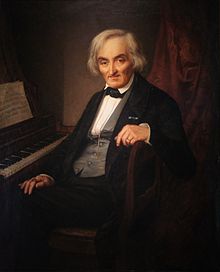Friedrich Kaufmann (instrument maker)

Johann Friedrich (Wilhelm) Kaufmann or Friedrich Wilhelm Kaufmann (born February 5, 1785 in Dresden ; † December 1, 1866 there ) was a watchmaker and musical instrument maker .
family
His father Johann Gottfried Kaufmann (1751 Siegmar near Chemnitz - 1818 Frankfurt / Main), a mechanic in Dresden, built flute and harp clocks. Between 1806 and 1815 Johann Friedrich Kaufmann and his father Johann Gottfried Kaufmann developed the belloneon , the harmonichord , the chordaulodion (string and pipe work) and the mechanical trumpeter . His son Friedrich Theodor Kaufmann (1823–1872) continued to build instruments and orchestras .
His grandfather Georg Friedrich Kauffmann (1679–1735) was a royal Saxon-Merseburg court and cathedral organist and court music director.
contacts
Friedrich Kaufmann has been to the same place several times with Georg Joseph Vogler and Johann Nepomuk Mälzel ; he himself reports in the Allgemeine musical newspaper that he was in Paris at the same time around 1807 as Mälzel.
Contemporary reports
A description of a concert given by the Kaufmann family at St Martin's Hall on Saturday June 21, 1851 was published in The Illustrated London News , with further reports to follow.
Translated quotes:
“His son, Friedrich (1785–1866), quickly made a name for himself. They experimented with mechanical music ”.
The American Monthly Magazine wrote in 1817: “Messrs Kaufmann, Senior and Junior von Dresden exhibited four instruments which together replace an orchestra. They call these instruments belloneon, chordalaudion, automaton trumpeter, harmonichord . Since these contain wind instruments, it can be compared to Mälzl's Panharmonikon , which was performed some time ago in London and Paris. "
“The Chordalaudion produces together and separately the tone of a pianoforte and that of four flutes, which intone with such accuracy and precision that the illusion is perfect. The automatons can produce two-part notes. The totally curious instruments are the successors of the Harmonichord ”“ Between the years 1842 and 1844 the Kaufmann family traveled again, this time accompanied by their son Friedrich Theodor. They took five instruments with them on their journey. After a very successful tour, a catastrophe happens. The ship they took home from Copenhagen got caught in a storm and they lost all instruments. Certainly they started to build a new and improved chordal audion and a symphonium ”.
literature
- Moritz Fürstenau: Merchant . In: Allgemeine Deutsche Biographie (ADB). Volume 15, Duncker & Humblot, Leipzig 1882, p. 465 f.
- Rebecca Wolf: Friedrich Kaufmann's trumpeter automaton. A musical experiment around 1810 (= Archive for Musicology . Supplement 68). Stuttgart 2011, ISBN 978-3-515-09381-1 .
- Conversation lexicon; or, Concise Encyclopedic Dictionary for Educated Estates Volume 1 of Conversations-Lexicon; or,
- Concise Encyclopedic Dictionary for the Educated Classes, 1816. AF Macklot, 1819, page 391 online
- Newspaper for the elegant world of Berlin: fashion, entertainment, art, theater, volume 14
- Die Zeitschriften des Junge Deutschland, 1814, page 1558, (Kaufmann copied Mälzl) Online
Web links
Individual evidence
- ↑ August Gathy: Musikalisches Conversations-Lexikon: Encyclopedia of Entire Music , 2nd edition Hamburg 1840, page 249
- ↑ Allgemeine Musikische Zeitung , Volume 10, March 5, 1823, footnote on p. 153
- ^ The American monthly magazine and critical review , Ed .: H. Biglow, OL Holley, Volume 1, 1817, p. 383
- ↑ quoted from: Arthur WJG Ord-Hume: Barrel organ. The story of the mechanical organ and its repair , London, Allen & Unwin, 1978, pages 169, 170
| personal data | |
|---|---|
| SURNAME | Kaufmann, Friedrich |
| ALTERNATIVE NAMES | Businessman, Johann Friedrich Wilhelm; Kaufmann, Friedrich Wilhelm; Kaufmann, Johann Friedrich |
| BRIEF DESCRIPTION | German musical instrument maker |
| DATE OF BIRTH | February 5, 1785 |
| PLACE OF BIRTH | Dresden |
| DATE OF DEATH | December 1, 1866 |
| Place of death | Dresden |